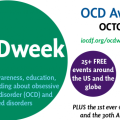Obsessive-Compulsive Disorder (OCD) – Decision Making Abnormalities
Does OCD affect decision making processes?
Now that we have reviewed the neurobiology of OCD and cognitive deficits associated with OCD, what relevance might this have for predicting abnormalities on tasks of decision making?
Sachdev and Malhi (2005) recently have drawn attention to the substantial overlap between the circuitry implicated in OCD and the circuitry required for intact performance on simple decision tasks. They suggest that due to the commonalities of these neural systems, individuals with OCD would be expected to exhibit deficits on tasks of decision making. Furthermore, they indicate that OCD might even be conceptualized appropriately as a disorder of decision making, given that many of the hallmark features of the disorder seemingly arise from a primary deficit in decision making processes. For example, OCD doubt and the inability to decide whether or not one’s hands have been washed sufficiently might reflect a general problem with processing decision-relevant information (i.e., recognizing the information value of a handwashing behavior). Their theory focuses largely on dysfunction within prefrontal cortex and other closely interconnected regions.
As noted previously, the PFC includes the dorsolateral prefrontal cortex (DLPFC), the orbitofrontal cortex (OFC) and the anterior cingulate cortex (ACC). The DLPFC is thought to facilitate decision making by processing and evaluating multiple environmental stimuli with the aid of working memory (D’Esposito et al., 1995; Prabhakaran, Narayanan, Zhao, & Gabrieli, 2000). The OFC has been implicated in the processing of affective information (particularly reward-related information) from limbic areas that subsequently is conveyed to the DLPFC as a positive or negative bias (Sachdev & Malhi, 2005). Affective and environmental stimuli then are integrated in the DLPFC in order to aid in action selection. During tasks that are associated with limited affective cues, the OFC likely conveys little bias to the DLPFC; however, during tasks that require more complex emotional processing, the affective bias conferred by the OFC might more critically affect action selection. In threatening situations characterized by marked emotional arousal, the OFC bias might be involved in selecting behaviors instrumental for guaranteeing survival. Sachdev and Malhi (2005) have suggested that activity in the OFC might contribute to “gut-feelings” that are experienced in particular situations. In disorders such as OCD that are associated with OFC hyperactivity, such gut feeling states presumably would be potentiated in emotionally intense situations and would increase the likelihood of selecting actions that minimize harm and promote survival. This is consistent with the idea that the function of OCD rituals is to reduce perceived feelings of danger and vulnerability.
As described earlier, OCD also is associated with specific alterations in ACC activity, as demonstrated by ERN studies. Sachdev and Malhi (2005) and others have suggested that ACC hyperactivity promotes feelings of wrongness and inhibits feelings of “closure in situations of uncertainty or conflict” which contributes to “rapid adjustment of [the] behavioural response.” Thus, conjoint ACC and OFC hyperactivation might account for many of the critical features of OCD, including the selection of survival-promoting compulsions that are functionally-related to obsessive thoughts, feelings of wrongness in uncertain situations, and doubt pertaining to whether or not a compulsion has been completed satisfactorily. Attentional biases for OCD-relevant cues might indicate hyperactivity at the level of the OFC, which conveys this information to the DLPFC. Impaired negative priming, which is associated with activation of the right DLPFC and posterior medial thalamus, might account for how these stimuli are able to gain salience in attention and acquire special significance for individuals with OCD (Egner & Hirsch, 2005).
The DLPFC, upon integrating information about threatening stimuli, would then be involved in the selection of a behavioral response that rapidly could reduce feelings of anxiety. However, even after initiating behavior to manage this anxiety, hyperactivity in the ACC could result in persistent doubt about how successfully the strategy has been implemented. It might be difficult to disengage from the strategy due to ambiguity about whether environmental contingencies have changed sufficiently to support the termination of the behavior. This could manifest empirically as neuropsychological impairments with executive processes, such as set-shifting and organizational strategy. A biological predisposition to form associations rapidly among anxiety, threatening stimuli, and the anxiolytic properties of compulsive behavior might contribute to the etiology of the disorder. Moreover, attentional biases for environmental threats might contribute to the acquisition of evidence supporting the dangerousness of, and necessity for action in, these situations. Sachdev and Malhi’s (2005) call for a decision-centric hypothesis for OCD is compelling given the substantial overlap in the neural systems presumed to underlie OCD and decision making, as well as the alterations in cognitive functioning that have been associated with the disorder. However, most of these hypotheses remain to be tested empirically.
Historically, several theories about OCD have focused on difficulties with decision making. Reed (1976) described OCD as being characterized by pathological doubt and indecision and interpreted OCD symptomatology as resulting from a need to overly structure the external environment due to an inability to spontaneously integrate and organize experience. He predicted that individuals with OCD would experience the greatest difficulty with tasks:
where the goal is not clear, the information is incomplete or the parameters are ill-defined. Indecisiveness will be most apparent in open-ended tasks requiring an intuitive, inductive approach. But in either case, the obsessional will look for conclusive information and may thus defer completion of the task.
Put simply, Reed (1976) believed that individuals with OCD had difficulties making “decisions about decisions.” Frost and Shows (1993) have found significant correlations between compulsive indecisiveness and general indecisiveness. Moreover, general indecisiveness was correlated with obsessionality, compulsive checking, perfectionism, and compulsive hoarding.
Beech has suggested that individuals with OCD might engage in ritualistic behavior in order “to avoid or postpone decisions which have unpredictable or possibly painful consequences” (from Reed, 1976, p. 443). Interestingly, Steiner (1972) has reported that individuals with OCD are less likely to engage in risky behaviors. Work by Steketee and Frost (1994) and Frost, Steketee, Cohn, and Griess (1994) supports these findings, showing that even individuals who exhibit subclinical OCD-like characteristics report avoiding risky situations in daily life (even situations unrelated to OCD-relevant concerns) relative to controls.
Theories can aid greatly in developing conceptualizations about clinical disorders; however, their value is limited in the absence of empirical support. Is there direct empirical evidence of impairments in decision making in individuals with OCD? Several empirical studies support this conceptualization. One of the earliest studies was conducted by Milner, Beech, and Walker (1971), who used a signal detection methodology to assess whether or not individuals with OCD have a heightened need for certainty before committing to decisions. Their results indicated that groups did not differ in overall signal detectability or response bias; however, individuals in the OCD group made significantly more requests for “repeats” of trials in comparison to controls. The authors interpreted this as evidence that individuals with OCD might differ in their evaluations of the subjective cost of further observations vs. the value of correct responses and costs of errors. Milner et al. (1971) concluded that individuals with OCD often exhibit a tendency to defer decision making until they have had ample time to obtain a preponderance of relevant information.
Recently, Foa et al. (2003) tested the effects of situational risk (i.e., low, high, and OCD-relevant) and information availability on decision making in OCD. Participants completed a series of binary preference tasks in which they were given access to one piece of information concerning the relative advantages or disadvantages associated with each of two alternatives (e.g., the probability of a negative outcome, a recommendation by “experts,” response popularity, a ranking of the alternatives by an authority). Participants then could either choose one of the two alternatives or obtain additional information to use in reaching a decision. Participants were allowed to request up to four additional pieces of information. Dependent variables included decision latencies (in seconds) and the number of additional pieces of information requested. Although Foa et al. (2003) failed to find a significant overall group by risk interaction, planned comparisons indicated that individuals with OCD requested more information before reaching decisions on low-risk and OC-relevant scenarios than did non-anxious controls. Groups did not differ on high-risk scenarios. For decision latencies, there was a significant group by risk interaction. Relative to controls, individuals with OCD took more time to reach decisions on scenarios characterized by low-risk and OC-relevant features.
Foa et al.’s (2003) study illustrates that the perceived riskiness of a situation might account for variability in decision making in OCD. Relative to non-anxious controls, individuals with OCD tend to require more information to express preferences for options on low-risk and OC-relevant tasks. However, this study offers little assistance for understanding the process by which individuals with OCD integrate information in order to make decisions about preferences. Furthermore, the experimental design of this study, while elegant, is confounded by the fact that participants were provided with different types of decision-relevant information across scenarios. No attempt was made to identify what types of information individuals with OCD prefer to use when making decisions. It also is noteworthy that when participants requested additional information to complete the preference task, the task was made even more ambiguous due to the low redundancy nature of the available cues.
Other direct evidence of impaired decision making in OCD comes from studies using the Iowa Gambling Task (IGT), a test sensitive to OFC dysfunction that assesses the influence of individual differences such as reward and punishment sensitivities on decision making behavior (Bechara, Damasio, Damasio, & Anderson, 1994). Cavedini et al. (2002) compared IGT performance among individuals with OCD, panic disorder, and healthy controls. Relative to individuals in the healthy control and panic disorder groups, individuals with OCD made significantly more disadvantageous choices overall and failed to shift to more advantageous strategies over the course of the task. In fact, individuals with OCD actually made significantly more disadvantageous choices as the task progressed, a pattern of responding that was consistent with an increased sensitivity to immediate gain. Interestingly, Cavedini et al. (2002) found that among OCD patients, poor task performance predicted a poor pharmacological treatment response. In a subsequent study, Cavedini, Bassi, Zorzi, and Bellodi (2004) found that task performance also could predict which individuals might benefit clinically from conjoint SSRI / atypical antipsychotic treatment. Patients who demonstrated good performance on the IGT benefited most from treatments consisting solely of SSRIs, whereas patients with poor performance on the IGT often benefited further by augmenting SSRI treatment with an atypical antispsychotic. This implies a possible role for dopamine in mediating decision making performance. However, the body of empirical evidence relating OCD to impairments in decision making on the IGT is not wholly consistent (Lawrence et al., 2006). Nielen, Veltman, de Jong, Mulder, & den Boer (2002) found no major differences in task performance between individuals with OCD and controls; however, among OCD patients, patients with more severe symptoms made significantly more disadvantageous choices than patients with less severe symptoms.
Full references for this page can be found here.
Questions? Comments? Sound off below.
Want Updates about New Content?
Follow Me!
Follow @drstevenseay












